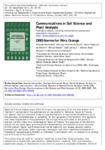Por favor, use este identificador para citar o enlazar este ítem:
http://www.alice.cnptia.embrapa.br/alice/handle/doc/1007099Registro completo de metadatos
| Campo DC | Valor | Lengua/Idioma |
|---|---|---|
| dc.contributor.author | HERNANDES, A. | pt_BR |
| dc.contributor.author | SOUZA, H. A. de | pt_BR |
| dc.contributor.author | AMORIM, D. A. de | pt_BR |
| dc.contributor.author | NATALE, W. | pt_BR |
| dc.contributor.author | LAVRES JUNIOR, J. | pt_BR |
| dc.contributor.author | BOATETTO, A. E. | pt_BR |
| dc.contributor.author | CAMACHO, M, A. | pt_BR |
| dc.date.accessioned | 2015-01-30T09:11:53Z | - |
| dc.date.available | 2015-01-30T09:11:53Z | - |
| dc.date.created | 2015-01-29 | pt_BR |
| dc.date.issued | 2014 | pt_BR |
| dc.identifier.citation | Communications in Soil Science and Plant Analysis, v. 45, n. 22, p. 2853-2867, Dec. 2014. | pt_BR |
| dc.identifier.uri | http://www.alice.cnptia.embrapa.br/alice/handle/doc/1007099 | pt_BR |
| dc.description | Abstract: Chemical analysis of leaves is an effective tool for detecting nutritional imbalances and providing data for fertilizer recommendations. Therefore, it is extremely important to establish criteria for interpreting these results. The DRIS (Diagnosis and Recommendation Integrated System) method is an alternative to the interpretation of results of leaf analysis as it allows the calculation of indexes for each nutrient, using its relations with others and comparing them with a reference population. Thus, we aimed to establish preliminary DRIS norms, by both Beaufils’s and Jones’s methods, and to derive critical levels and nutrient sufficiency ranges in the leaf tissue for Pêra orange, by studying a commercial crop in the growing conditions of the São Paulo state. The methods (Beaufils and Jones) differed in the limiting nutrients in the Pêra orange orchard. The use of regional norms must be prioritized because of differences between the management methods applied. In the methods used, the nutrients that had a greater number of concordant cases in decreasing order: Mn > Mg > B > N > Cu > Fe > Zn > K > P > Ca. Amplitudes related to the DRIS methods used were narrower than the conventional literature. | pt_BR |
| dc.language.iso | eng | eng |
| dc.rights | openAccess | eng |
| dc.subject | Nutritional diagnosis | pt_BR |
| dc.subject | DRIS | pt_BR |
| dc.subject | Fertilization | pt_BR |
| dc.subject | Leaf tissue analysis | pt_BR |
| dc.subject | Sweet oranges | pt_BR |
| dc.title | DRIS norms for pêra orange. | pt_BR |
| dc.type | Artigo de periódico | pt_BR |
| dc.date.updated | 2015-01-30T09:11:53Z | pt_BR |
| dc.subject.thesagro | Citrus sinensis | pt_BR |
| dc.subject.thesagro | Laranja Pêra | pt_BR |
| dc.subject.thesagro | Nutrição vegetal | pt_BR |
| dc.subject.thesagro | Adubação | pt_BR |
| dc.subject.thesagro | Análise foliar | pt_BR |
| dc.subject.nalthesaurus | Citrus fruits | pt_BR |
| dc.subject.nalthesaurus | Nutritive value | pt_BR |
| riaa.ainfo.id | 1007099 | pt_BR |
| riaa.ainfo.lastupdate | 2015-01-29 | pt_BR |
| dc.identifier.doi | http://dx.doi.org/10.1080/00103624.2014.956933 | pt_BR |
| dc.contributor.institution | Amanda Hernandes, Universidade Estadual Paulista (Unesp) - Jaboticabal, SP, Brazil; HENRIQUE ANTUNES DE SOUZA, CNPC; Daniel Angelucci de Amorim, Unesp - Jaboticabal, SP, Brazil; William Natale, Unesp - Jaboticabal, SP, Brazil; José Lavres Junior, Centro de Energia Nuclear na Agricultura (CENA/USP) - Piracicaba, SP, Brazil; Antonio Enedi Boaretto, CENA/USP - Piracicaba, SP, Brazil; Marcos Antonio Camacho, Universidade Estadual de Mato Grosso do Sul (UEMS) - Aquidauana, Brazil. | pt_BR |
| Aparece en las colecciones: | Artigo em periódico indexado (CNPC)  | |
Ficheros en este ítem:
| Fichero | Descripción | Tamaño | Formato | |
|---|---|---|---|---|
| cnpc2014DRIS.pdf | 204,06 kB | Adobe PDF |  Visualizar/Abrir |









